Find more information in the General Comments section of the assessment
Find more information in the Rating Validity tab of the assessment
- See More
- See More
- See More
- See More
- Good
- Adequate
- Marginal
- Weak
- Poor
 Passenger
Passenger
 Driver
Driver
 Rear Passenger
Rear Passenger
 Driver
Driver
 Car
Car
 Pole
Pole
 Rear Seat
Rear Seat
 Front Seat
Front Seat
- Good
- Adequate
- Marginal
- Weak
- Poor


Passenger
outboard
Fitted to the vehicle as standard
Not fitted to the test vehicle but available as option
Not Available
-
Infants up to 13 kg
-
Infants and toddlers up to 18 kg
-
Toddlers from 9 to 18 kg
-
Toddlers over 18 kg
Easy
Difficult
Safety critical
Not allowed
| Seat Position | ||||
|---|---|---|---|---|
| Front | 2nd row | |||
| Passenger | Left | center | Right | |
| Maxi Cosi Cabriofix (Belt) | ||||
| Britax Römer King Plus (Belt) | ||||
| Britax Römer Duo Plus (ISOFIX) | ||||
| Britax Römer KidFix (Belt) | ||||
| Maxi Cosi Cabriofix & EasyFix (Belt) | ||||
| Maxi Cosi Cabriofix & EasyFix (ISOFIX) | ||||
| BeSafe iZi Kid X3 ISOfix (ISOFIX) | ||||
| Maxi Cosi Pearl & Familyfix (ISOFIX) | ||||
| Britax Römer KidFix (ISOFIX) | ||||
Easy
Difficult
Safety critical
Not allowed
Based on dummy readings in the dynamic tests, the Mazda 2 scored maximum points for its protection of the 1½ year dummy. Forward movement of the head of the 3 year dummy, sat in a forward-facing restraint, was not excessive but dummy readings indicated high values of neck tension and marginally high readings for chest deceleration. The recommended child restraints could not be fitted for the side barrier impact as the front seats are positioned too far rearward. Mazda showed, using in-house side barrier tests, that the two child dummies are properly contained within the protective shells of their restraints, minimising the likelihood of head contact with parts of the vehicle interior. The passenger airbag can be disabled to allow a rearward-facing dummy to be used in that seating position. Clear information is provided to the driver regarding the status of the airbag and the system was rewarded. All of the types of child restraints for which the car is designed could be fitted and accommodated with the exception of the semi-universal group 0+/1 restraint which could not be installed in the rear behind the driver's seat.
- Good
- Adequate
- Marginal
- Weak
- Poor

Head Impact 18.5 Pts
Pelvis Impact 5.8 Pts
Leg Impact 6.0 Pts
The bumper provided good protection to pedestrian's legs in all areas tested and scored maximum points. Protection provided to the pelvis area was predominantly good. The surface of the bonnet provided good protection to the head of a struck pedestrian over most of its surface, with poor results recorded only on the stiff windscreen pillars.
- Good
- Adequate
- Marginal
- Weak
- Poor
| Speed Limit Information Function | N/A |
| Warning Function | Manually set |
| Speed Limitation Function | Manually set |
| Performance | ||
| Vehicle Yaw Rate @ COS + 1.00 s | 0% | meets ECE requirements |
| Vehicle Yaw Rate @ COS + 1.75 s | 0% | meets ECE requirements |
| Lateral Displacement @ BOS + 1.07 s | 2.8 m | meets ECE requirements |
| Applies To | All seats | ||
| Warning | Driver Seat | Front Passenger(s) | Rear Passenger(s) |
| Visual | |||
| Audible | |||
|
|||
| System Name | LDWS |
| Type | Lane Departure Warning |
| Warning | Audible & Visual |
| Performance | |
|
LDW Confirmation Test
|
Pass |
Electronic stability control is standard equipment as is a seatbelt reminder system for the front and rear seats. A driver-set speed limitation device is an option but is expected to be fitted to most cars sold so was included in the assessment and met Euro NCAP's requirements for systems of this type. Similarly, a lane departure warning system is available as an option and was rewarded in the assessment. There is no high speed (inter-urban) autonomous braking system available for the Mazda 2.
- Specifications
- Safety Equipment
- Videos
- Rating Validity
Specifications
Tested Model Mazda 2 1.5 'Core', LHD
Body Type - 5 door hatchback
Year Of Publication 2015
Kerb Weight 1027kg
VIN From Which Rating Applies - all Mazda 2's
Class City and Supermini
Safety Equipment
Note: Other equipment may be available on the vehicle but was not considered in the test year.
Fitted to the vehicle as standard
Fitted to the vehicle as option
Not fitted to the test vehicle but available as option
Not Available
Not Applicable
Videos
Rating Validity








Find more information in the General Comments section of the assessment
 Share
Share

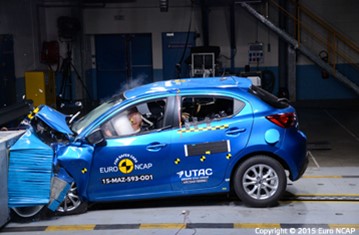
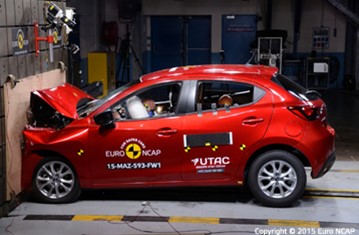
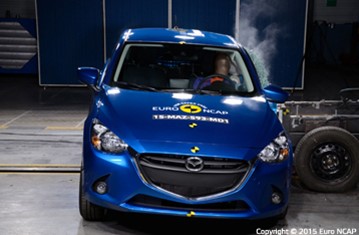
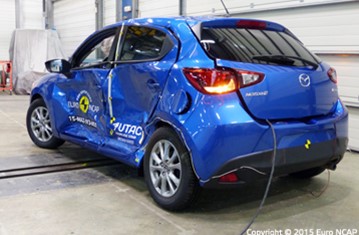
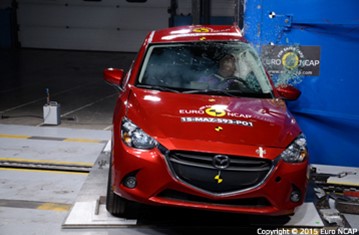
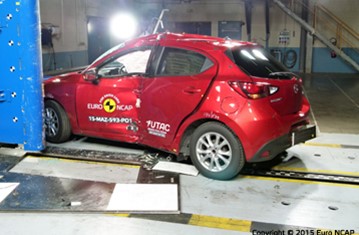



The passenger compartment of the Mazda 2 remained stable in the frontal offset barrier test. In that test, maximum points were scored for the protection of the passenger dummy and only a fraction of a point was lost for the driver. Dummy readings indicated good protection of the knees and femurs of both front seat occupants and Mazda showed that a similar level of protection would be provided to occupants of different sizes and to those sat in different seating positions. In the full-width frontal test, good protection was provided to all body regions of the front seat passenger except the neck, protection of which was rated as marginal owing to the neck extension measured during the test. Protection of the rear seat passenger was rated as good or adequate for all body regions. Maximum points were scored in the side impact barrier test, with good protection of all critical body regions. Even in the more severe side pole impact, protection was good and maximum points were scored. For the front seats and head restraints, tests indicated good protection against whiplash injuries in the event of a rear-end collision but a geometric assessment of the rear seats indicated poor protection. A low-speed autonomous emergency braking system is available as an option for the Mazda 2. However, as it is not standard equipment, the system did not qualify for inclusion in the assessment.